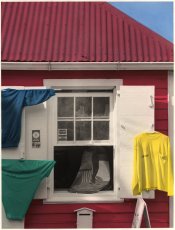The paper was Kodak's Panalure. The original wasn't that great, and even the H contrast (Hard) was a bit soft. The later version, Panalure Select RC, was actually quite good and the S, M, H grades seemed accurate. I liked it and have a few prints on it that I still like. I wish someone would make such a paper again. It's just a black and white paper that's panchromatic. It has to be handled in either complete darkness or under a dim safelight made for color paper. I used it with my Duka 50 sodium safelight set for RA4 paper and never had a problem with that.
Not just the base but the fact there are different colors in the image messes with VC paper, meaning different parts of the image can print with different contrasts. It also tends to come out looking oddly grainy, probably because of the lack of red sensitivity - any dye clouds too red just don't register at all leaving large "holes" that look like grain. Graded paper is even worse since its sensitivity is even more limited.
Hey Simon - could Ilford make a good panchromatic paper for this, please?

Probably the best way to do this and get good tonality might be to print onto film and reversal process for a negative, then print that. You could reversal process black and white or, heck, just use E6 if some filter experimentation could eliminate any color cast. A slight cast wouldn't hurt much, as long as it wasn't too red.












